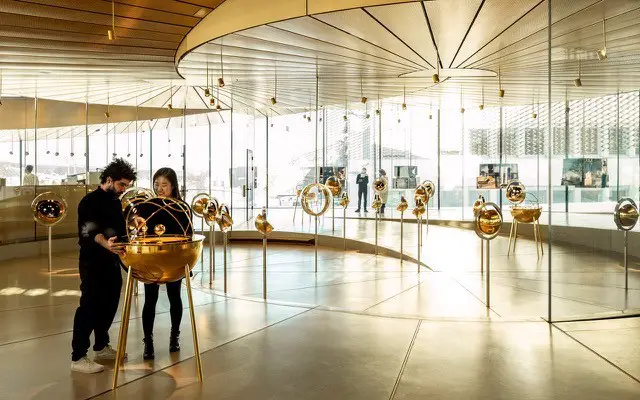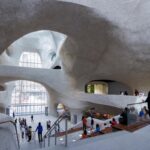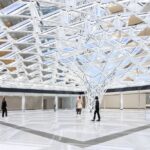Musée Atelier Audemars Piguet, Swiss architecture, Switzerland visitors attraction building, Architecture photos
Musée Atelier Audemars Piguet in Le Brassus, Switzerland
Architects: BIG and ATELIER BRÜCKNER
Location: Le Brassus, Switzerland
24 Apr 2020
Musée Atelier Audemars Piguet
On the outskirts of the small village of Le Brassus, secluded in a high mountain valley of the Swiss Jura, the Musée Atelier Audemars Piguet – an iconic total work of art of the Bjarke Ingels Group (BIG) and ATELIER BRÜCKNER, the scenography specialist – opens its doors on 25 June.
The spiral-shaped building is embedded in the surrounding landscape and features curved walls made of load-bearing structural glass. Optically flowing transitions characterise the exhibition. Depending on the time of day and the season, the overall impression changes. Reflections and shadows combine to create a spectacle in which the course of time is inscribed.
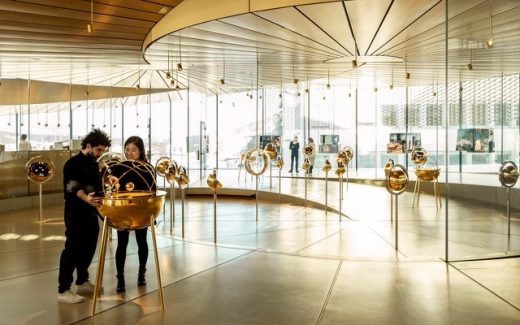
Musée Atelier Audemars Piguet: The Complications. Photography: Giovanni Emilio Galanello
The museum is situated in the historical location where the company of the luxury watch brand Audemars Piguet was established in 1875. In the light-filled new building, ATELIER BRÜCKNER has incorporated a rhythmically flowing route through the exhibition. It starts in the historic building and, going in a clockwise direction, slopes gently down into the heart of the spiral, after which it rises again in the contrary direction – filled with energy like the springs of a watch. Visitors experience the route as a flowing continuum with a composed narration.
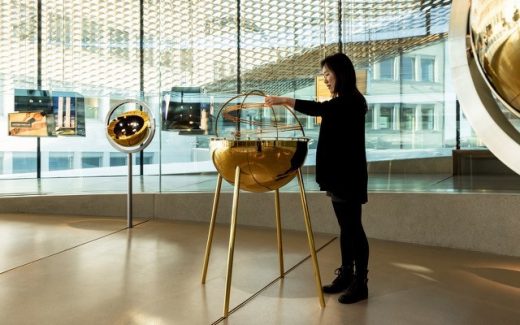
Musée Atelier Audemars Piguet: The Complications – The Chronograph. Photography: Giovanni Emilio Galanello
Each chapter has its own design language and is introduced by an interlude, a mechanical sculpture or an artistically designed display item. The showcases are positioned within the architecture precisely. Their appearance changes, depending on the particular part of the narration being provided and the architectonic requirement. Apart from glass, defining materials are brass, bleached ash and glossy black lacquer as a surface coating.
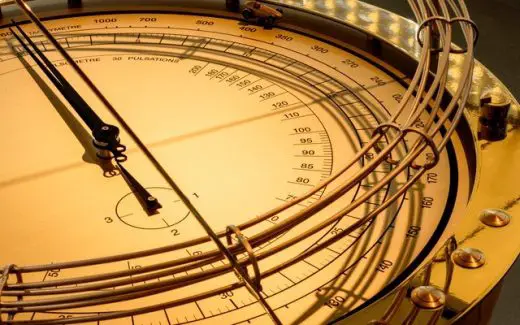
Musée Atelier Audemars Piguet: The Complications – Chronograph Detail. Foto: Giovanni Emilio Galanello
The history of the company serves as a starting point of the narration. A ferrous boulder references the significance of metal for the development of a tradition of craftsmanship in this isolated region. This is followed by a kinetic model that illustrates the geographical location of the village of Le Brassus and its distance away from Geneva, to which the components of highly complex watch mechanisms were delivered from the 17th century onwards. A three-dimensional genealogical tree provides an overview of the Audemars and Piguet families and how families in the Vallée de Joux worked together to make watches.
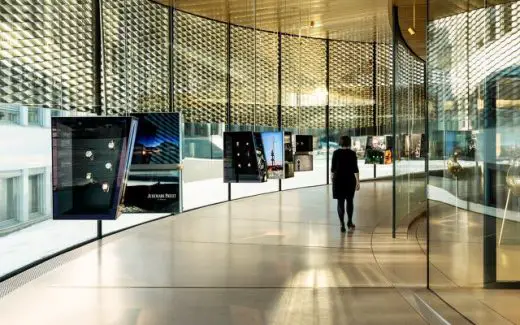
Musée Atelier Audemars Piguet: Designing Time. Photography: Giovanni Emilio Galanello
More than 300 timepieces – each one unique and a superlative exemplar – are shown in the exhibition. A start is made with early works of the watchmaking art, including a pocket watch by Jules Louis Audemars made of 18 carat rose gold, which combines a perpetual eternal calendar with the mechanism of quarter-hour repetition and the independent “jumping” second.
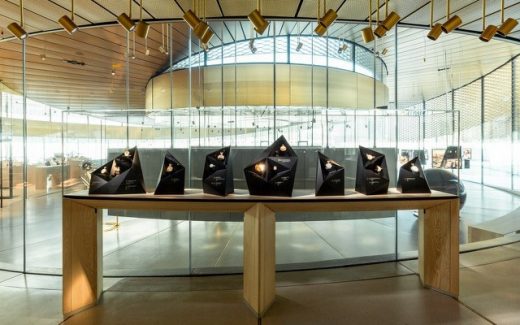
Musée Atelier Audemars Piguet: The First Watchmakers. Photography: Giovanni Emilio Galanello
The complicated pocket watch by Joseph Piguet, dating from around 1769, is the oldest object of the exhibition and undoubtedly its masterpiece. The items are presented in black showcases that are reminiscent of angular blocks of iron ore.
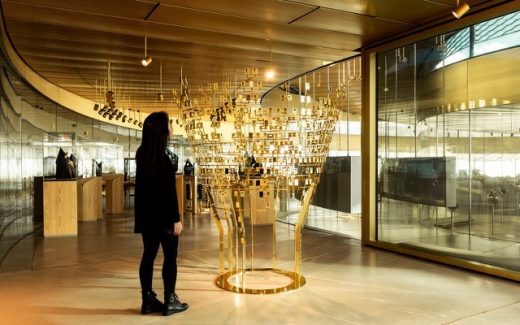
Musée Atelier Audemars Piguet: The Origins. Photography: Giovanni Emilio Galanello
After the “First Watchmakers”, the focus turns to the “Mechanical Heart” of the watches, which is introduced with an artistic sculpture by François Junod and accompanied by mechanical models, which visitors can use to see how individual components interact with each other. The wheel train, the escapement and the balance wheel become visually accessible and comprehensible.
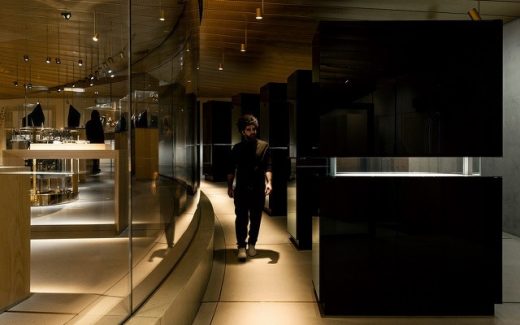
Musée Atelier Audemars Piguet: Royal Oak. Photography: Giovanni Emilio Galanello
With this knowledge, the visitor now approaches the “Complications” in the heart of the spiral. They are the core feature of the company’s brand. The most well-known complications, which have been associated with the name Audemars Piguet since time immemorial, namely “Astronomy”, “Chiming” and “Chronograph”, are demonstrated by mechanical installations. The larger the number of complications, the more complex the watch mechanism.
At the centre of the architecture and the exhibition, there is a single watch that has an incredible 21 complications: the “Universelle” is the most complicated watch that Audemars Piguet has ever created. The unique specimen from the year 1899 has exactly 1168 individual parts. It is presented in a glass sphere, whereby the front and rear are shown as equally valuable views. Eight other watches with Grande Complications are placed around the “Universelle”. The design is reminiscent of a solar system with planets rotating around a sun on their orbits. After all, astronomic cycles are what determine the essence of watchmaking.
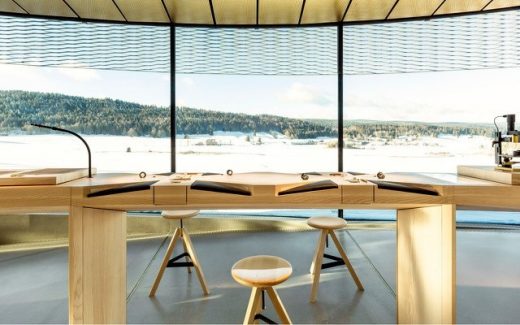
Musée Atelier Audemars Piguet: The Crafts. Photography: Giovanni Emilio Galanello
Following the “Complications”, there are the “Superlatives” with the thinnest and smallest watches, introduced by the installation “Seeing the Invisible”: microscopes designed as telescopes illustrate how unbelievably small and fine the components of a watch are – in some cases as thin as a human hair. In the “Designing Time” area with its suspended showcases and poster reproductions, the exhibition is dedicated to watches as an expression of their time from the Belle Époque to the 21st century. And finally, individual masterpieces can be seen that make reference to the design process.
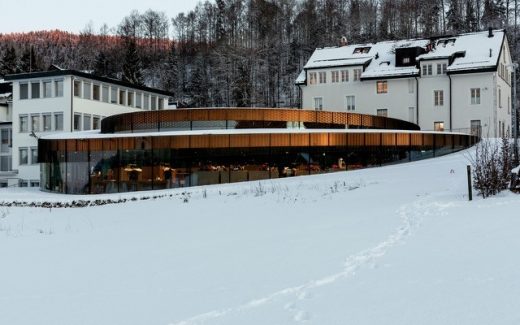
Musée Atelier Audemars Piguet: Exterior. Architecture by BIG. Photography: Giovanni Emilio Galanello
At a workbench, visitors can re-enact the technical and design aspects of this craft as well as the design process, for example by polishing surfaces with fine sandpaper and screwing tiny screws into a metal plate – an especially difficult challenge. At this moment at the latest, the difficulty of the work that the professional watchmaker does becomes clear.
Workshops for “Grandes Complications” and “Métiers d`Art” are integrated in the extended route through the exhibition and can be viewed any time. The degree of concentration the work requires can be sensed directly; it necessitates craftsmanship of unbelievable precision. All the steps involved in making a watch are demonstrated manually on site. In the hands of an individual watchmaker, a watch can take from six to nine months to make.
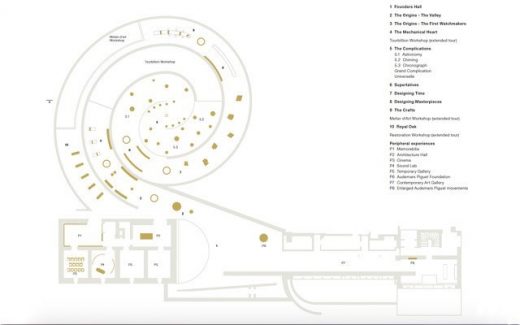
Musée Atelier Audemars Piguet: Floor Plan
The route through the exhibition ends with a staged setting that shows off the Royal Oak collection. The wristwatch with its octagonal bezel and hexagon metal screws has been the flagship watch of the company since the 1970s. Its automatic mechanism with central rotor was the thinnest in the world for decades. Even today, the world’s first luxury sports watch made of steel is a central defining component of the company’s image.
Five glossy black blocks, which also serve as screens on which films can be shown, open themselves up – like gift boxes, as it were – as soon as the staged setting is triggered. They reveal the popular masterpieces, which are still being bought today.
BIG Architects / Atelier Brueckner
Visits to the museum can be booked in advance. Registration at the Musée Atelier Audemars Piguet website – www.museeatelier-audemarspiguet.com
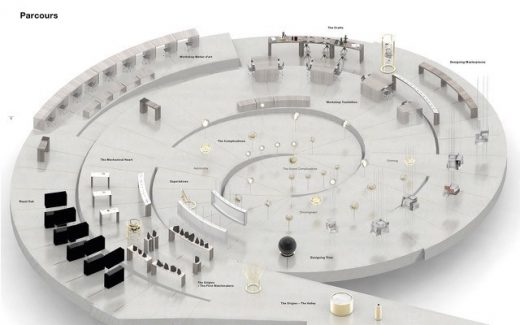
Musée Atelier Audemars Piguet: Isometry
Architects: BIG and Atelier Brückner Gmbh
Photography: Giovanni Emilio Galanello
Musée Atelier Audemars Piguet in Le Brassus, Switzerland images / information received 240220
Location: Le Brassus, Switzerland
Architecture in Switzerland
Swiss Architecture Designs – chronological list
Swiss Architecture Walking Tours
Hôtel des Horlogers Building by BIG
Swiss Houses – selection below:
Flexhouse, Lake Zurich
Architect: Evolution Design
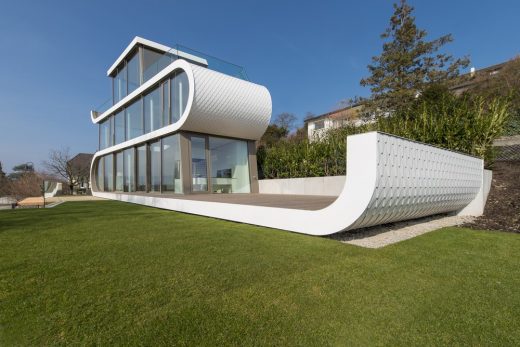
photograph © Peter Wuermli
Flexhouse on Lake Zurich
House in Lumino, Ticino
Design: Davide Macullo Architects
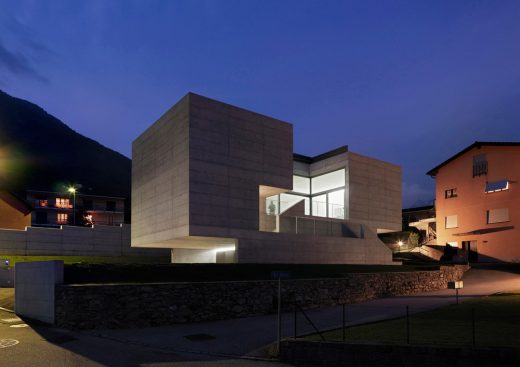
photo : Enrico Cano
New House in Ticino
Villa G in Sorengo, Lake Lugano
Design: SCAPE, architects
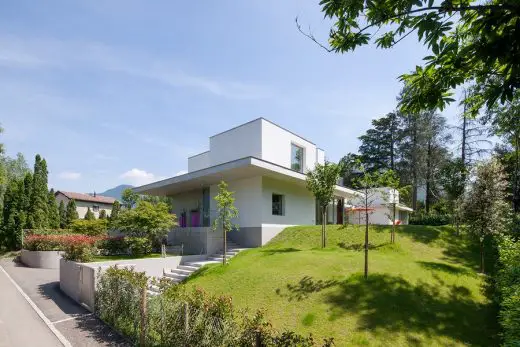
photograph : Francesco Mattuzzi
Villa G in Sorengo: Lugano House
Comments / photos for this Musée Atelier Audemars Piguet in Le Brassus, Switzerland page welcome

